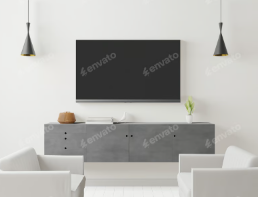Choosing the right wall mount for your TV is essential to enhance your viewing experience while ensuring safety and aesthetics. Here’s a detailed guide to help you make the right choice:
1. Determine Your TV Size and Weight
- Size Compatibility: Check the TV’s size (measured diagonally) and ensure the wall mount supports it. Each mount has a specified size range.
- Weight Limit: Verify the TV’s weight and ensure the wall mount can support it. This information can typically be found in the TV specifications.
2. Understand Different Types of Wall Mounts
- Fixed Mounts: These are the simplest mounts that hold the TV flush against the wall. They are best for a clean look but do not allow for any adjustment.
- Tilting Mounts: These mounts allow you to tilt the TV downward, making them ideal for high wall placements. They provide a better viewing angle without the hassle of glare.
- Full-Motion (Articulating) Mounts: These offer the most flexibility, allowing you to pivot and extend the TV from the wall. They are perfect for corner installations or when the seating is not directly facing the TV.
3. Check the VESA Pattern
- VESA Compatibility: TVs have a pattern of mounting holes on the back, known as the VESA (Video Electronics Standards Association) pattern. Check the distance between the holes (in millimeters) and ensure the wall mount you choose is compatible with that pattern.
4. Evaluate Your Wall Type
- Studs vs. Solid Walls: Determine whether your wall is drywall, concrete, or brick. Most mounts require installation into studs for safety, so locate studs with a stud finder. If you’re mounting on drywall only, consider using wall anchors specifically designed for heavy loads.
5. Consider Viewing Height and Angle
- Optimal Height: The center of the TV screen should be at eye level when you’re seated. A good rule of thumb is about 42 inches from the floor to the center of the screen for typical viewing.
- Viewing Angle: If you’re mounting the TV higher, consider a tilting or full-motion mount to avoid neck strain and glare.
6. Plan for Cable Management
- Hiding Cables: Look for mounts that come with built-in cable management systems, or consider purchasing cable covers to keep the installation neat. If you’re using an in-wall system, ensure it’s compliant with local building codes.
7. Assess Local Regulations and Safety Standards
- Building Codes: Be aware of any local regulations regarding wall mounting. Ensure that the chosen mount meets safety standards to protect against accidents.
8. Read Reviews and Seek Recommendations
- Product Reviews: Research reviews and ratings from other users before making a purchase. Specific models may have unique features or issues, so getting firsthand accounts can be invaluable.
- Ask for Advice: Don’t hesitate to ask friends, family, or professionals for recommendations based on their experiences with TV wall mounts.
9. Budget Considerations
- Price Range: Wall mounts can vary significantly in price. Set a budget and look for options within that range. Remember, investing a little more in a quality mount can save money in the long run by ensuring safety and durability.
Taking the time to choose the right wall mount for your TV can improve your viewing experience and the overall look of your space. By considering factors such as size, weight, type of mount, VESA compatibility, wall type, viewing angle, and cable management, you can find the perfect mounting solution for your home.
